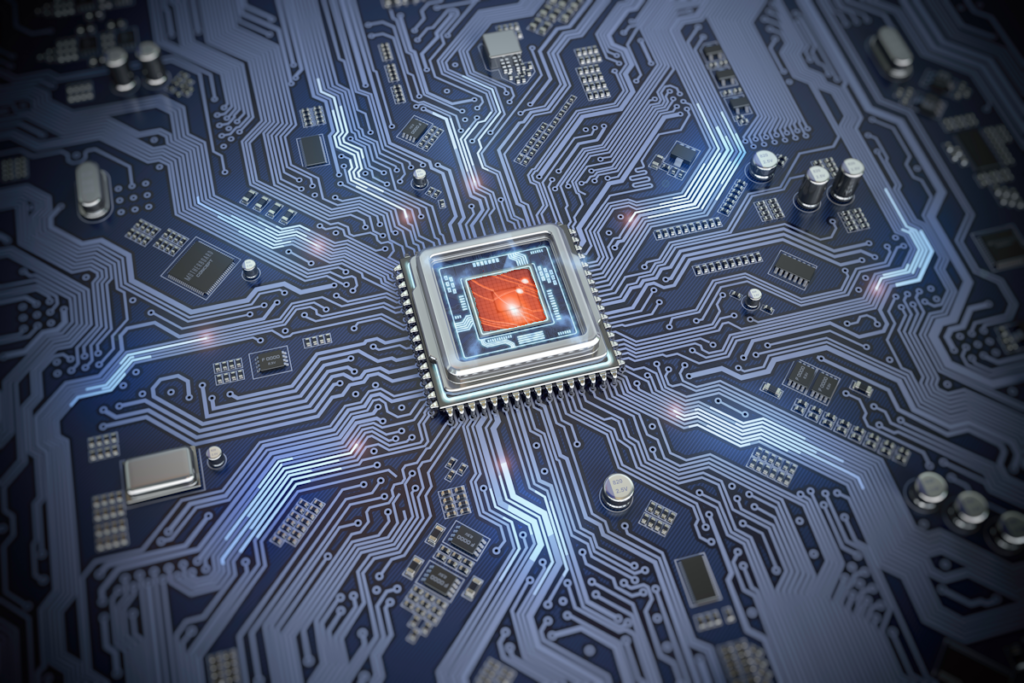Researchers almost start drooling at the prospect of having access to a programmable, universal quantum computer. As astrophysicist and science writer Alfredo Carpineti observes, “Quantum computers have the potential to revolutionize information technology, processing problems that even our most powerful supercomputers can’t solve.”[1] He goes on to note that quantum computers always seem to be tantalizingly out of reach. He explains, “Problems [that might be solved by quantum computing] require quantum computers that have millions of qubits (quantum bits), while today’s quantum computers operate on a 100-qubit scale.” The challenge to generating more qubits, according to journalist Dalvin Brown, is that qubits are finicky entities. He explains, “Quantum computing is weighed down by hard-to-control qubits, which are error prone and often die.”[2]
As most people know, today’s ubiquitous computers operate using binary information and each binary digit is either a zero or a one. However, like so many things found at the quantum level, qubits defy logic. Qubits have the unique ability to be both a zero and a one simultaneously. In terms of computing power, this intrinsic quality is enormous. James Norman, Global Head of Sustainable Investing Client Strategy at Goldman Sachs, explains, “Quantum computers can be game changers because they can solve important problems no existing computer can. While conventional computing scales linearly, QC scales exponentially when adding new bits. Exponential scaling always wins, and it’s never close.”[3]
As Brown noted above, qubits are difficult to work with. To become functional qubits, atomic particles must be placed in a superposition state. Fortunately, quantum mechanics allows the qubit to be in a coherent superposition of both states (i.e., zero and one) simultaneously. In addition, multiple qubits can exhibit quantum entanglement. The late Albert Einstein famously called entanglement “spooky action at a distance.” Wikipedia explains, “Quantum entanglement is a nonlocal property of two or more qubits that allows a set of qubits to express higher correlation than is possible in classical systems.” If those explanations sound confusing and difficult, it’s because they are. Science writer Evrim Yazgin explains, “Using the complex and irregular quantum principles of superposition and entanglement to build a functioning computer is not easy. Current quantum machines, though representing huge leaps forward in our understanding and technical abilities, are rife with errors.”[4]
Recent Breakthroughs in Quantum Computing
Recent breakthroughs may address two of the challenges noted above: generating more qubits and reducing errors.
Generating More Qubits
Yazgin points out, “Most quantum computers today run on a very small number of quantum bits (or qubits). Late last year, IBM announced that they had a quantum computer, IBM Osprey, with 433 qubits. This more than tripled the previous largest quantum processor which had 127 qubits, IBM Eagle. As significant as these developments are, if we’re speaking honestly, a quantum computer with more than three or four qubits is a nightmare to run. The very same quantum effects which promise to make quantum computers so powerful, are also making it very difficult to build.”[5] However, that may be changing.
In January, the University of New South Wales (UNSW) announced, “Australian engineers have discovered a new way of precisely controlling single electrons nestled in quantum dots that run logic gates. What’s more, the new mechanism is less bulky and requires fewer parts, which could prove essential to making large-scale silicon quantum computers a reality.”[6] According to the UNSW staff, the new discovery, by engineers at the quantum computing start-up Diraq and UNSW Sydney, was serendipitous. Will Gilbert, a quantum processor engineer at Diraq, stated, “This was a completely new effect we’d never seen before, which we didn’t quite understand at first. But it quickly became clear that this was a powerful new way of controlling spins in a quantum dot. And that was super exciting.”
As the UNSW staff explains, “Logic gates are the basic building block of all computation; they allow ‘bits’ — or binary digits (0s and 1s) — to work together to process information.” Engineers at Diraq believe their new method of creating spin will help them achieve their ambition of building billions of qubits on a single chip. That would be a game changer.
Reducing Errors
Because quantum computers work with sub-atomic particles, the staff at University Of Innsbruck, notes, “Quantum computers are inherently much more susceptible to disturbances and therefore error correction mechanisms will almost certainly always be required. Otherwise, errors would propagate uncontrolled in the system and information would be lost.”[7] One way they suggest addressing the problem of errors is to create redundancies. However, doing that at the quantum level, the University of Innsbruck staff notes, can be tricky: “Because the fundamental laws of quantum mechanics forbid copying quantum information, redundancy can be achieved by distributing logical quantum information into an entangled state of several physical systems, for example, multiple individual atoms.”
They report that last year a research team at the university was able to conduct “a set of computational operations on two logical quantum bits that can be used to implement any possible operation.” Lukas Postler, a doctoral student at the university, explained why this breakthrough was important. He stated, “For a real-world quantum computer, we need a universal set of gates with which we can program all algorithms.” The research team was able to create this universal gate set “on an ion trap quantum computer featuring 16 trapped atoms. The quantum information was stored in two logical quantum bits, each distributed over seven atoms. Now, for the first time, it has been possible to implement two computational gates on these fault-tolerant quantum bits, which are necessary for a universal set of gates: a computational operation on two quantum bits (a CNOT gate) and a logical T gate, which is particularly difficult to implement on fault-tolerant quantum bits.” The bottom line, according to the University of Innsbruck staff is this: “The physicists have now demonstrated all the building blocks for fault-tolerant computing on a quantum computer.”
Moving Data Between Microchips
Science correspondent Pallab Ghosh observes, “Computer scientists have been trying to make an effective quantum computer for more than 20 years. … One stumbling block has been the need to transfer quantum information between chips quickly and reliably: the information degrades, and errors are introduced.”[9] That challenge may have recently been overcome. The University of Sussex reports that a research team from the university and a company called Universal Quantum has, for the first time, demonstrated that qubits can directly transfer between quantum computer microchips. According to a news release from the university, “The University of Sussex and Universal Quantum team were successful in transporting the qubits with a 99.999993% success rate and a connection rate of 2424/s, both numbers are world records and orders of magnitude better than previous solutions.”[10]
Concluding Thoughts
The scientific community waits with bated breath for the first universal, programmable quantum computer. Every announcement of a breakthrough step brings that goal a little closer. The University of Innsbruck staff has also announced that a team of researchers has broken out of the binary computing framework using quantum digits (qudits) rather than binary qubits. They report, “Restricting researchers to binary systems prevent [computer driven] devices from living up to their true potential. The [University of Innsbruck] research team succeeded in developing a quantum computer that can perform arbitrary calculations with so-called quantum digits, thereby unlocking more computational power with fewer quantum particles. Unlike the classical method, the new method that utilizes more states does not negatively impact the reliability of the computer. The researchers have developed a quantum computer that can make use of the full potential of these atoms.”[8] Although activity at the quantum level can be mind-bending, those “spooky” actions are bringing the world ever closer to developing a new type of powerful computer.
Footnotes
[1] Alfredo Carpineti, “Major Breakthrough Paves The Way For Powerful Quantum Computers Today,” IFL Science, 8 February 2023.
[2] Dalvin Brown, “Google’s new ‘time crystals’ could be a breakthrough for long-awaited quantum computers,” The Washington Post, 12 August 2021.
[3] James Norman, “Quantum Computing Will Revolutionize Data Analysis. Maybe Soon,” Seeking Alpha, 14 March 2018.
[4] Evrim Yazgin, “First demonstration of universal operations on an error-free quantum computer,” Cosmos Magazine, 27 May 2022.
[5] Evrim Yazgin, “Accidental breakthrough by Australian scientists could be key to large scale quantum computers being cheaper and more usable,” Cosmos Magazine, 17 January 2023.
[6] Staff, “New spin control method brings billion-qubit quantum chips closer,” Phys.org, 12 January 2023.
[7] Staff, “Fundamental Breakthrough: Error-Free Quantum Computing Gets Real,” SciTechDaily, 28 May 2022.
[8] Veda Aravali, “Quantum Computers can Look Beyond Zeros and Ones! Research Reveals,” Analytics Insight, 3 August 2022.
[9] Pallab Ghosh, “Quantum breakthrough could revolutionise computing,” BBC News, 8 February 2023.
[10] Staff, “Another step towards practical quantum computers,” University of Sussex, 8 February 2023.





